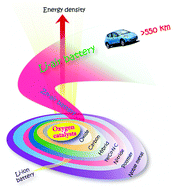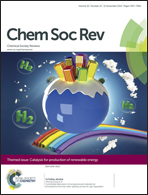Oxygen electrocatalysts in metal–air batteries: from aqueous to nonaqueous electrolytes
Abstract
With the development of renewable energy and electrified transportation, electrochemical energy storage will be more important in the future than it has ever been in the past. Although lithium-ion batteries (LIBs) are traditionally considered to be the most likeliest candidate thanks to their relatively long cycle life and high energy efficiency, their limited energy density as well as cost are still causing a bottleneck for their long-term application. Alternatively, metal–air batteries have been proposed as a very promising large-scale electricity storage technology with the replacement of the intercalation reaction mechanism by the catalytic redox reaction of a light weight metal–oxygen couple. Generally, based on the electrolyte, these metal–air batteries can be divided into aqueous and nonaqueous systems, corresponding to two typical batteries of Zn–air and Li–air, respectively. The prominent feature of both batteries are their extremely high theoretical energy density, especially for nonaqueous Li–air batteries, which far exceeds the best that can be achieved with LIBs. In this review, we focus on the major obstacle of sluggish kinetics of the cathode in both batteries, and summarize the fundamentals and recent advances related to the oxygen catalyst materials. According to the electrolyte, the aqueous and nonaqueous electrocatalytic mechanisms of the oxygen reduction and evolution reactions are discussed. Subsequently, seven groups of oxygen catalysts, which have played catalytic roles in both systems, are selectively reviewed, including transition metal oxides (single-metal oxides and mixed-metal oxides), functional carbon materials (nanostructured carbons and doped carbons), metal oxide–nanocarbon hybrid materials, metal–nitrogen complexes (non-pyrolyzed and pyrolyzed), transition metal nitrides, conductive polymers, and precious metals (alloys). Nonaqueous systems have the advantages of energy density and rechargeability over aqueous systems and have gradually become the research focus of metal–air batteries. However, there are considerable challenges beyond catalysts from aqueous to nonaqueous electrolytes, which are also discussed in this review. Finally, several future research directions are proposed based on the results achieved in this field, with emphasis on nonaqueous Li–air batteries.

- This article is part of the themed collection: Catalysis for Production of Renewable Energy

 Please wait while we load your content...
Please wait while we load your content...